For more information about this program, please contact the physics department Astrophysics group. The astrophysics research series takes place most Wednesday afternoons from 2-3 pm while class is in session (google calendar available here). If you are interested in giving a seminar, please contact Prof. Cara Battersby.
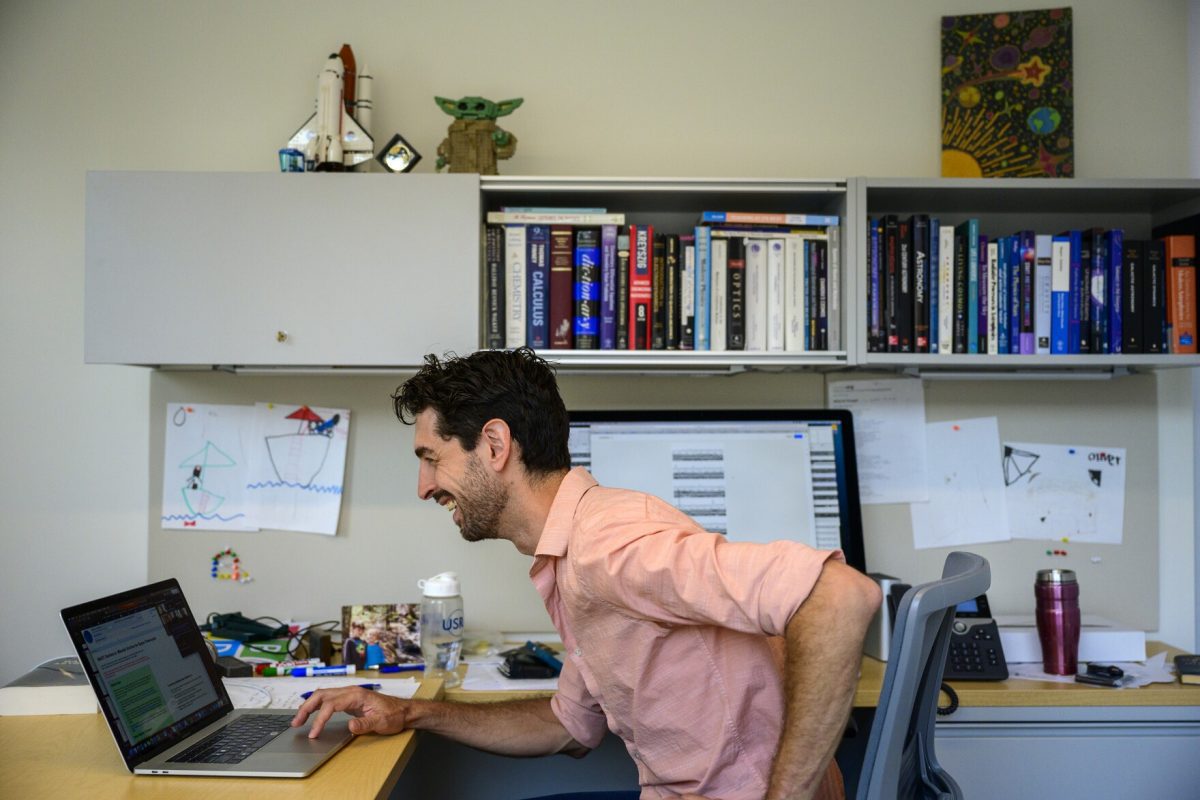
Prof. Jonathan Trump Interviews about the James Webb Space Telescope
The James Webb Space Telescope released its first science observations on July 12 with much fanfare and excitement across the globe. UConn Physics Professor Jonathan Trump is part of the Cosmic Evolution Early Release Science collaboration that was awarded some of the first observations on the transformative new space telescope. Prof. Trump was interviewed by several local media outlets, […]
[Read More]
Prof. Cara Battersby Awarded an NSF CAREER grant
Professor Cara Battersby has been awarded an NSF CAREER grant! “The Faculty Early Career Development (CAREER) Program is a Foundation-wide activity that offers the National Science Foundation’s most prestigious awards in support of early-career faculty who have the potential to serve as academic role models in research and education and to lead advances in the […]
[Read More]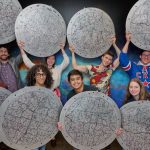
Plates that Helped Map the Universe, Now at UConn
UConn is now home to tools that have played an instrumental role in mapping the universe — 10 large aluminum plates used as part of the Sloan Digital Sky Survey (SDSS). Measuring 32 inches across, one-eighth of an inch thick, and with thousands of tiny holes drilled in them, these plates may not be the […]
[Read More]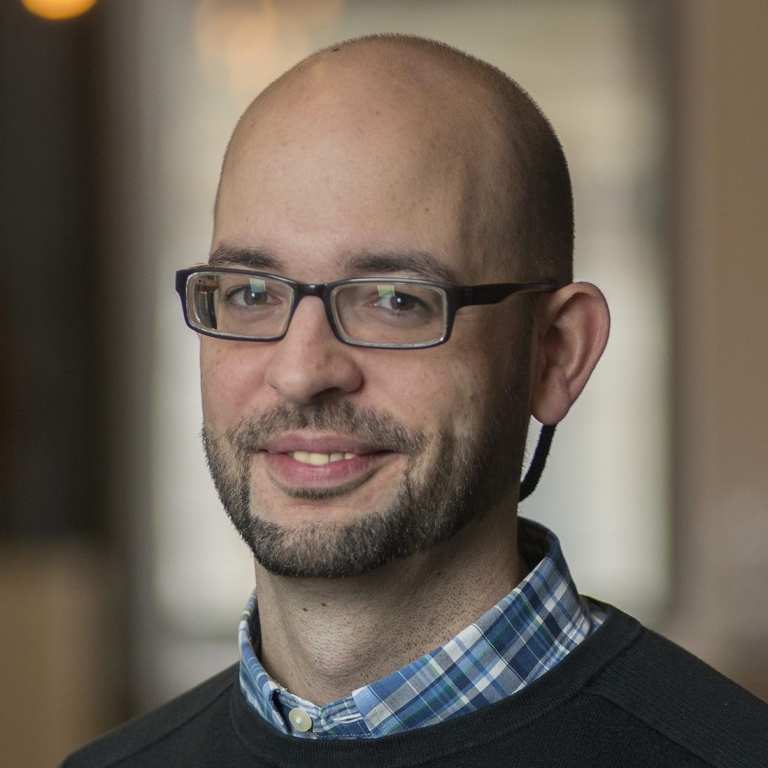
Research of UConn Professor Daniel Angles-Alcazar featured in UConn Today
The article The Largest Suite of Cosmic Simulations for AI Training Is Now Free to Download; Already Spurring Discoveries describe research of a team of astrophysicists that includes UConn Professor of Physics Daniel Anglés-Alcázar. “Machine learning is revolutionizing many areas of science, but it requires a huge amount of data to exploit,” says Anglés-Alcázar. “The […]
[Read More]
Prof. J. Trump interview about the launch of the James Webb telescope
UConn Physics Professor Jonathan Trump is part of a group of scientists who will be the first to conduct research using the James Webb space telescope. The local Fox News TV station conducted an interview with Prof. Trump.
[Read More]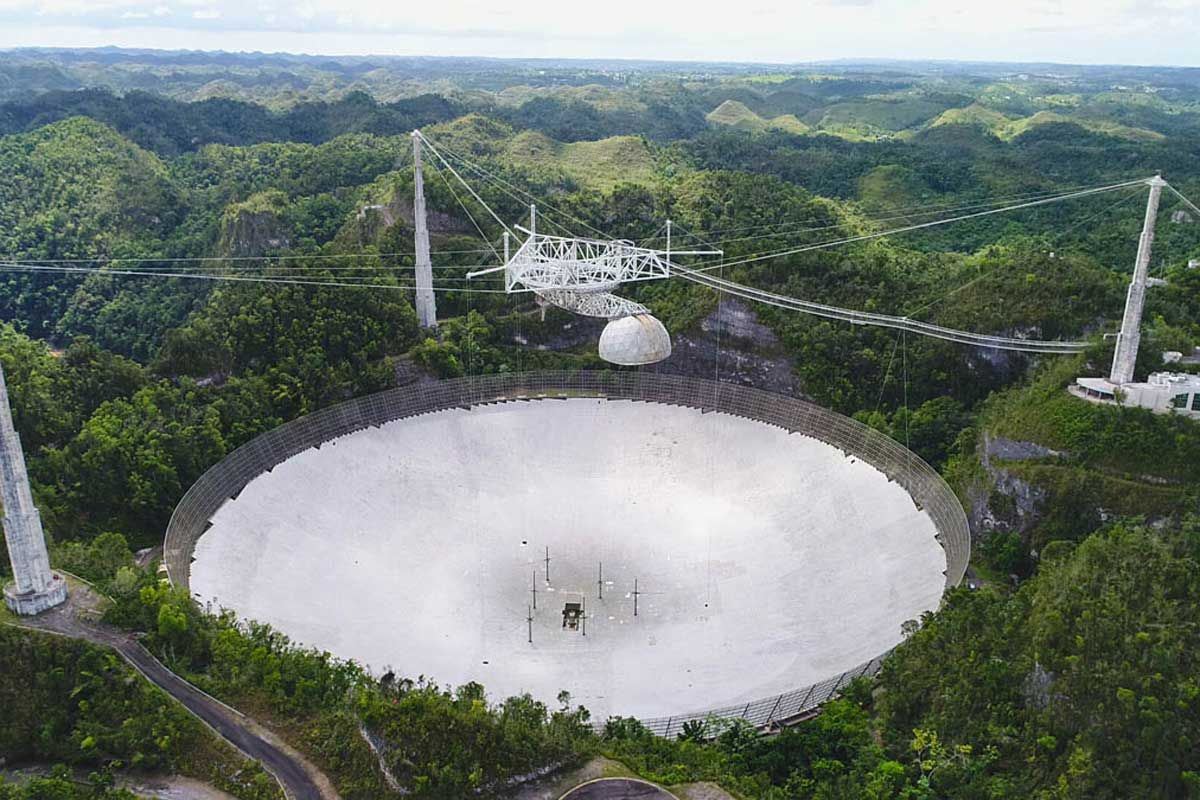
U.S. Senators introduce a resolution to recognize the Arecibo Observatory Telescope
On Friday December 3rd, a group of U.S. Senators, Richard Blumenthal (D-CT), Edward J. Markey (D-MA), Marco Rubio (R-FL), Elizabeth Warren (D-MA), and Rick Scott (R-FL) introduced a bipartisan a resolution to recognize the significant scientific, educational, and economic contributions made by the Arecibo Observatory telescope. “The telescope at Puerto Rico’s Arecibo Observatory was a […]
[Read More]
Prof. Chiara Mingarelli awarded NSF grant
Chiara Mingarelli, Assistant Professor of Physics at UConn, is the lead researcher on a $650,000 Collaborative Research Grant from the National Science Foundation, half of which is earmarked for UConn, to conduct an experiment to prove the existence of supermassive black hole binaries. This grant will combine, for the first time, traditional astronomy with gravitational […]
[Read More]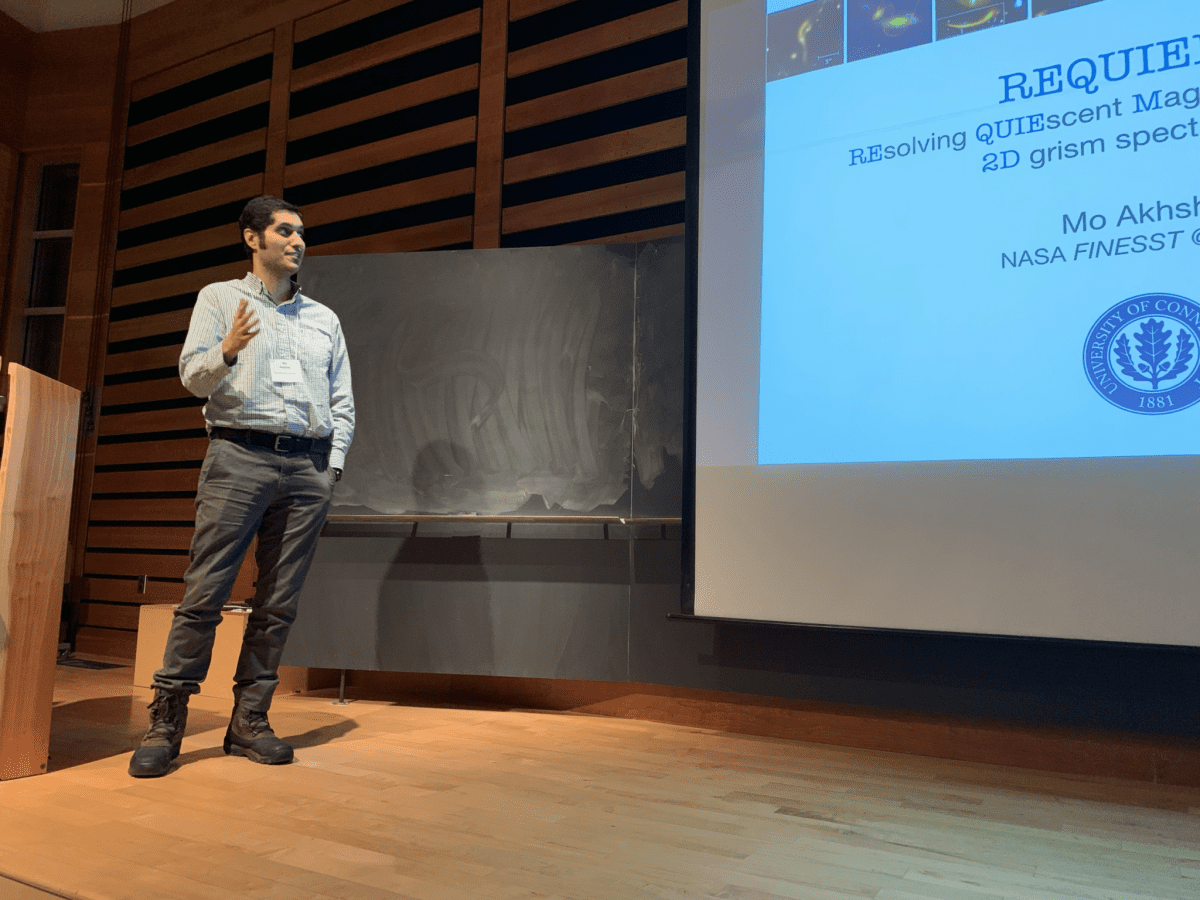
A Physics Ph.D. Student’s Step-By-Step Journey to Storrs and Distant Galaxies
UConn Physics graduate student Mohammed (Mo) Akhshik works on data gathered using the Hubble Space Telescope (HST) and has led to exciting discoveries, some while he served as the science Principle Investigator of the REQUIEM HST program from which he is co-author on two publications, one in Nature and one in Nature Astronomy. Akhshik is also […]
[Read More]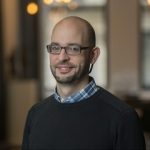
Professor Daniel Anglés-Alcázar research featured in ‘UConn Today’ and CBC radio interview
At the center of galaxies, like our own Milky Way, lie massive black holes surrounded by spinning gas. Some shine brightly, with a continuous supply of fuel, while others go dormant for millions of years, only to reawaken with a serendipitous influx of gas. It remains largely a mystery how gas flows across the universe […]
[Read More]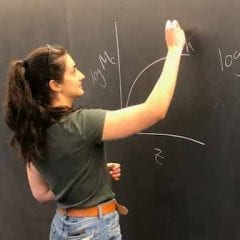
Undergraduate Researcher Nicole Khusid featured in UConn Today
Physics major Nicole Khusid, a rising senior at UConn, was featured in a UConn Today article about her research. Nicole has been working on gravitional lensing of distant sources of gravitational waves, seeking to understand their multimessenger signals and detectability by future astrophysics facilities. Nicole was awarded a SURF (Summer Undergraduate Research Fund) award to […]
[Read More]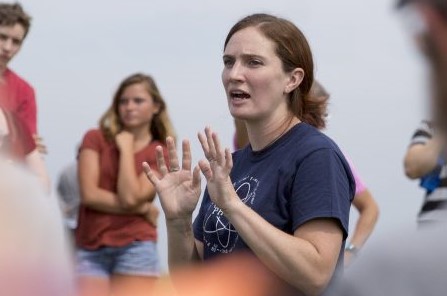
Prof. Battersby’s research featured in UConn Today article
Professor Cara Bettersby’s research is featured in the article “The Study of Big Data: How CLAS Researchers Use Data Science” published by UConn Today. Prof. Battersby’s work focuses on describing and studying the center of the Milky Way galaxy, which she calls an “experimental playground” for the distant cosmos. Her work described the spectroscopy of […]
[Read More]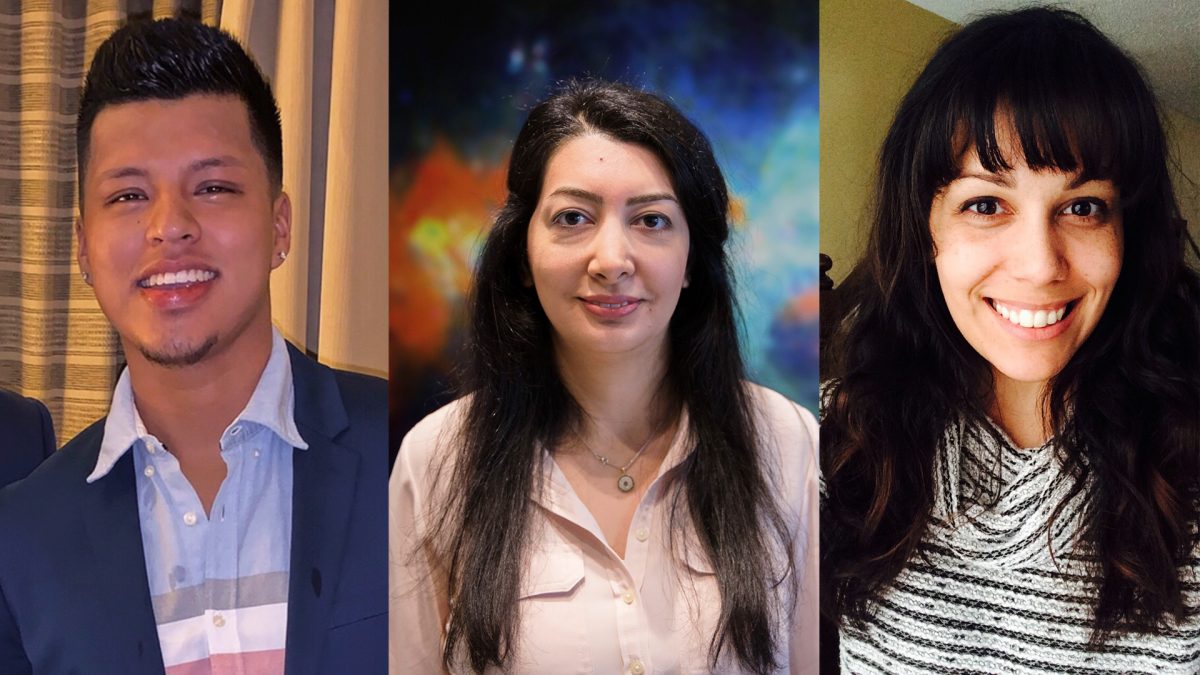
Dr. Yasaman Homayouni featured in CLAS story on 2021 graduates
New Physics PhD graduate Yasaman Homayouni is featured in a story on the class of 2021 from the College of Liberal Arts and Sciences (CLAS). For the full story of what inspired Yasaman and other students during their time at UConn, see the article in UConn Today.
[Read More]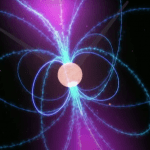
A Signal from Beyond
UConn astrophysicist Chiara Mingarelli is part of a team of researchers who recently published data on a hint of a signal that sent ripples of excitement through the physics community. These monumental findings are the culmination of twelve and a half years of data gathered from NANOGrav — a network of pulsars across the galaxy — all in the hopes of detecting gravitational waves.
[Read More]
UConn Researcher an Architect for Astronomical Survey Making Observations Toward a New Understanding of the Cosmos
November 2, 2020 – Elaina Hancock – UConn Communications The Sloan Digital Sky Survey’s fifth generation – a groundbreaking project to bolster our understanding of the formation and evolution of galaxies, including the Milky Way – collected its very first observations on the evening of October 23. Image: The Sloan Digital Sky Survey’s fifth generation […]
[Read More]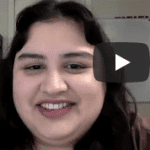
AAS Author Interview with Gloria Fonseca Alvarez
UConn graduate student Gloria Fonseca Alvarez was featured with a video in the Author Interview series produced by the American Astronomical Society (AAS). In this video, Gloria talks about her work to understand the inner environments of black holes. The paper highlighted in the video shows that the orbits of emission-line gas around supermassive black holes are often smaller than expected from previous observations.
[Read More]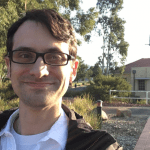
New Physics Faculty: Chris Faesi
We are very excited to extend a warm welcome to a new UConn Physics Faculty member, Dr. Christopher Faesi. Chris is an astrophysicist, specializing in both observational work and modelling, primarily in the study of star formation. He got his PhD at Harvard University, followed by a postdoc at the Max Planck Institute for Astronomy […]
[Read More]
Jonathan Trump wins NSF Early Career Award
Jonathan Trump, Assistant Professor of Physics, will receive $738,090 over five years to compile a census of supermassive black holes in the universe. This will give insights into how supermassive black holes and galaxies evolve across cosmic time. Trump will also develop a bridge program for underrepresented undergraduate physics majors at UConn to increase their […]
[Read More]
Astronomer Jonathan Trump interviewed on UConn 360
UConn Astrophysicist and observational astronomer Jonathan Trump was a recent guest on UConn 360, a podcast from the Storrs campus of the University of Connecticut. In this conversation, Jonathan tells about how attending a lecture as an undergraduate at Penn State captured his interest and changed the course of his professional career. Now Jonathan offers […]
[Read More]
Amelia Henkel, Graduating President of the Undergraduate Women in Physics Club, speaks about her time at UConn
Amelia Henkel, graduating Double Major in Physics and Human Rights, and President of the Undergraduate Women in Physics Club, speaks on the CLAS website about her passion for physics and human rights, and how she mastered challenges in her remarkably interdisciplinary curriculum. “We really need to interact with other disciplines,” says Amelia, “because that’s […]
[Read More]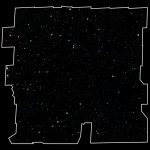
Astronomers Assemble View of Evolving Universe
The University of Connecticut’s Katherine Whitaker is part of a team of astronomers who have put together the largest and most comprehensive “history book” of the universe from 16 years’ worth of observations from NASA’s Hubble Space Telescope.This image, a mosaic of nearly 7,500 separate Hubble exposures, presents a wide portrait of the distant universe and contains roughly 265,000 galaxies that stretch back through 13.3 billion years to just 500 million years after the Big Bang.
[Read More]
UConn Astronomers React to First Photo of a Black Hole
This image is the first ever taken of a black hole, captured by the Event Horizon Telescope (EHT) project. The black center is a direct view of the event horizon of a supermassive black hole with a mass of 6.5 billion times the Sun, lying at the center of the Virgo cluster of galaxies. The bright ring is emission from hot gas just above the event horizon, with an asymmetric shape caused by gravitational lensing of light in the strong gravity of the black hole. The EHT collaboration captured the image using a network of 8 radio telescopes that spanned the Earth.
[Read More]
Kate Whitaker wins the Sloan Fellowship!
Original UConn Today article here Rising Star in Astrophysics Receives Sloan Foundation Fellowship February 19, 2019 – Jessica McBride – Office of the Vice President for Research Kate Whitaker, assistant professor of physics, stands next to a telescope inside the observatory on top of the Gant Complex on Feb. 14, 2019. (Peter Morenus/UConn Photo) As […]
[Read More]
Faculty Profile: UConn Astrophysicist Cara Battersby
A young Cara Battersby once scrawled out the phrase “Science is curious” in a school project about what she wanted to do when she grew up.
This simple phrase still captures Battersby’s outlook on her research about our universe.
Recently shortlisted for the 2018 Nature Research Inspiring Science Award, Battersby has been working on several projects aimed at unfolding some of the most compelling mysteries of galaxies near and far.
“I’m really interested in how stars are born,” Battersby says. “They’re the source of all life on Earth.”
Battersby is leading an international team of over 20 scientists to map the center of the Milky Way Galaxy using the Submillimeter Array in Hawaii, in a large survey called CMZoom. She was recently awarded a National Science Foundation grant to follow-up on this survey and create a 3D computer modeled map of the center of the Milky Way Galaxy.
[Read More]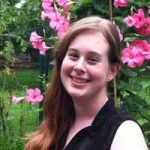
Physics undergrad is the recipient of 2018 Mark Miller research award
Physics major Brenna Robertson has been selected as the recipient of the 2018 Mark Miller Undergraduate Research Award. Brenna’s proposal, which focuses on modeling supermassive black hole spin using spectral emission diagrams, was selected from among a strong pool of applicants. Brenna Robertson is working with Prof. Jonathan Trump. The Mark Miller Award is a […]
[Read More]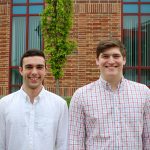
NASA awards to two physics undergraduate students
Undergraduate Physics Majors, Sam Cutler and Anthony (Josh) Machado, recently received awards from the NASA Connecticut Space Grant Consortium. Sam was awarded an Undergraduate Research Fellowship to perform research at UConn this summer working with Prof. Kate Whitaker. The title of his research project is “Examining High Redshift Rotation Curve Outside the Local Universe”. Josh […]
[Read More]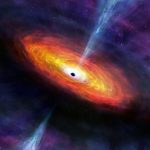
One Giant Leap in Mapping the Universe
An artist’s rendering of hot material falling into a supermassive black hole, creating what is called the accretion disk, shown in orange. Reverberation mapping measures the time it takes light to travel between two areas of the accretion disk. The ‘light echo’ enables direct measurement of the mass of the black hole. This reverberation mapping […]
[Read More]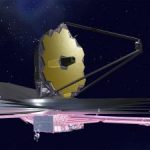
Astronomers granted early science time on James Webb space telescope
Two UConn physics professors will be among the world’s first scientists to explore the universe using the new James Webb Space Telescope. The highly competitive, peer-reviewed James Webb Space Telescope Early Release Science program was created to test the capabilities of the new observatory and to showcase the tools the telescope is equipped with. Of more than 100 proposals submitted, only 13 were chosen to participate in the early release phase, including two separate proposals involving UConn researchers Kate Whitaker and Jonathan Trump, both assistant professors of physics.
[Read More]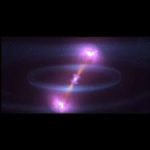
New gravity wave detection signals collision of two dead stars
For the first time, scientists have directly detected gravitational waves — ripples in space-time — in addition to light from the spectacular collision of two neutron stars. This marks the first time that a cosmic event has been viewed in both gravitational waves and light. The discovery was made using the U.S.-based Laser Interferometer Gravitational-Wave […]
[Read More]